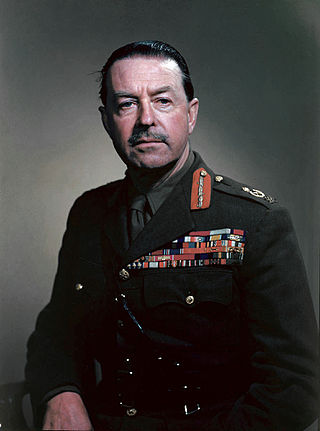
Field marshal is the second most senior military rank, ordinarily senior to the general officer ranks, but junior to the rank of Generalissimo. Usually, it is the highest rank in an army, and as such, few persons are ever appointed to it. It is considered as a five-star rank (OF-10) in modern-day armed forces in many countries. Promotion to the rank of field marshal in many countries historically required extraordinary military achievement by a general. However, the rank has also been used as a divisional command rank and also as a brigade command rank. Examples of the different uses of the rank include Afghanistan, Austria-Hungary, Pakistan, Prussia/Germany, India and Sri Lanka for an extraordinary achievement; Spain and Mexico for a divisional command ; and France, Portugal and Brazil for a brigade command.
Marshal is a term used in several official titles in various branches of society. As marshals became trusted members of the courts of Medieval Europe, the title grew in reputation. During the last few centuries, it has been used for elevated offices, such as in military rank and civilian law enforcement.
Generalfeldmarschall was a rank in the armies of several German states and the Holy Roman Empire (Reichsgeneralfeldmarschall); in the Habsburg monarchy, the Austrian Empire and Austria-Hungary, the rank Feldmarschall was used. The rank was the equivalent to Großadmiral in the Kaiserliche Marine and Kriegsmarine, a five-star rank, comparable to OF-10 in today's NATO naval forces.
Grand admiral is a historic naval rank, the highest rank in the several European navies that used it. It is best known for its use in Germany as Großadmiral. A comparable rank in modern navies is that of admiral of the fleet.

General admiral or Admiral general was first a Dutch then Danish, German, Russian, Portuguese, Spanish and Swedish naval rank. Its historic origin is a title high military or naval dignitaries of early modern Europe sometimes held, for example the (nominal) commander-in-chief of the Dutch Republic's navy.
Wonsu is the highest military rank in the armed forces of North Korea and South Korea.
Marshal of the air force or marshal of the air is a five-star rank and an English-language term for the most senior rank in some air forces. It is usually the direct equivalent of a general of the air force in other air forces, a field marshal or general of the army in many armies, or a naval admiral of the fleet.

Modern Russian military ranks trace their roots to the Table of Ranks established by Peter the Great. Most of the rank names were borrowed from existing German/Prussian, French, English, Dutch, and Polish ranks upon the formation of the Russian regular army in the late 17th century.
Master of the Horse is an official position in several European nations. It was more common when most countries in Europe were monarchies, and is of varying prominence today.

Field marshal is the highest rank of the Australian Army and was created as a direct equivalent of the British military rank of field marshal. It is a five-star rank, equivalent to the ranks in the other armed services of Admiral of the Fleet in the Royal Australian Navy, and Marshal of the Royal Australian Air Force. The subordinate army rank is general.
Taewonsu is the highest possible military rank of North Korea and is intended to be an honorific title for Kim Il-sung and Kim Jong-il. It is often confused with Marshal of the Republic and Marshal of the Korean People's Army, but ranks above both. The rank is senior to that of Wonsu. The title also exists in Chinese military history as dàyuánshuài, and was briefly taken by Sun Yat-sen.
The People's Liberation Army (PLA) has not always used ranks or insignia. In common with the practice of the Red Army at the time of its founding in 1927, neither were used until 1955 when a system of ranks was established. As a result of the Cultural Revolution, ranks were abolished in May 1965. After the Sino-Vietnamese War of 1979, reforms in the PLA began to be made to professionalize the armed forces once more. The 1984 Military Service Law provided for the resumption of rank, but disagreements on what ranks were to be used and who would receive them caused the revival of rank to be delayed until 1988. The following ranks and their respective insignia shown are those used by the People's Liberation Army Ground Force.
Gensui (元帥) may refer to:
Rikugun-gensui, formal rank designations: Gensui-rikugun-taishō was the highest title in the pre-war Imperial Japanese military.
Yuanshuai was a Chinese military rank that corresponds to a marshal in other nations. It was given to distinguished generals during China's dynastic and republican periods. A higher level rank of Dayuanshuai, which corresponds to generalissimo was awarded to Chiang Kai Shek of the Republic of China. It was also proposed for Mao Zedong on the mainland, but he ultimately never accepted it.

Dayuanshuai was a Chinese military rank, usually translated as grand marshal or generalissimo.

Marshal of the Empire was a civil dignity during the First French Empire. It was created by Sénatus-consulte on 18 May 1804 and to a large extent reinstated the formerly abolished title of Marshal of France. According to the Sénatus-consulte, a Marshal was a grand officer of the Empire, entitled to a high-standing position at the court and to the presidency of an electoral college.
The Supreme Commander-in-chief of the Imperial Japanese Army and Navy was the highest rank of the Imperial Japanese Army and the Imperial Japanese Navy from 1872 to 1945, when the Empire of Japan was dissolved. The rank was only ever held by the Emperor of Japan as commander-in-chief of the Imperial Japanese Armed Forces and, separately, the highest-ranking officer in each of the military branches. It formally became obsolete in 1947 when the Imperial Japanese military was abolished.
In many nations, the highest military ranks are classed as being equivalent to, or are officially described as, five-star ranks. However, a number of nations have used or proposed ranks such as generalissimo, which are senior to their five-star equivalent ranks.

The Highest Commander of the Royal Thai Armed Forces is a position vested in the Thai monarch, who as sovereign and head of state is the commander-in-chief of the Royal Thai Armed Forces.






